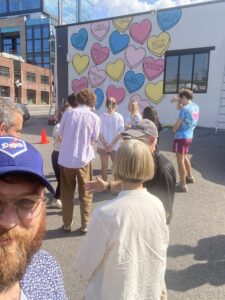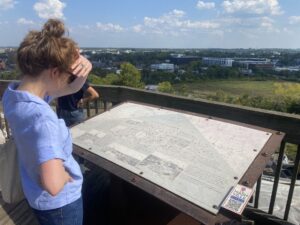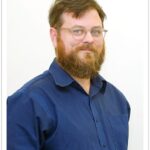What Makes a Successful City?
Peter Chesney is a Collaborative Humanities Postdoctoral Program Fellow with the Department of History of Art & Architecture.
The Successful City
Vanderbilt University hosted a symposium, “Universities, Cities, and Communities,” on September 21-22, 2023, to examine the question, “What makes a successful city?”
A successful city is defined by
the resilience of its long-standing
communities, not its visitors’
passing fancies.
One key to a successful city is actually higher education. Colleges and universities can improve the quality of life in cities and surrounding areas. On the flip side, universities like Vanderbilt, may fortify and expand their campuses at the expense of neighboring working-class communities of color. At once both frank and hopeful, our discussion planted the seeds for a future where an elite urban university like ours will wield the power to remake the city around it more responsibly, less harmfully, and more inclusively.
Two of the speakers were Dr. Henry Louis Taylor, Jr., who directs the Center for Urban Studies for the SUNY at Buffalo and Dr. Joe Trotter, who directs the Center for African American Urban Studies & the Economy at Carnegie Mellon. They discussed how centers such as theirs could serve as models for how a “rustbelt” city’s flagship university can make itself most useful for the wellbeing of the most disadvantaged residents living in nearby urban spaces.
For Taylor, that means moving adeptly between understanding Buffalo’s Black community as non-monolithic and deconstructing the U.S.’s “racialized neighborhood hierarchies.” To overthrow the legacies of anti-Blackness, scholar-activists must establish multi-expert teams with an interdisciplinary toolbox appropriate for addressing the complexities of today’s cities. According to Trotter, this complexity arises from the agency of Black people at the grassroots level and their excellence in the art of place making. The American city would not be the success story it is without the people of color who have populated and cultivated it.
Remaking Universities
Dana Cuff, who directs cityLAB at UCLA, talked about the agency of urban people in the remaking of universities. This architecture think tank was founded in the aftermath of Hurricane Katrina and the flooding of New Orleans. Reconstruction demanded architects trained not just in design but also in seeking spatial justice.

Since then, cityLAB has provided a gateway for productive new thinking about cities from places as far as East Japan after the 2011 earthquake and from as near as the MacArthur Park and Pacoima neighborhoods of Los Angeles. Perhaps cityLAB’s greatest success story arose from lessons learned in neighborhoods of new immigrants where Latinx residents took plots of land zoned for single-family housing. They then used informal methods of auto-construction to establish duplexes, to convert garages, and to add backyard units. Cuff’s cityLAB lobbied for changes in state law that instituted the formalization of this existing housing portfolio and the breakdown of legal barriers to the production of more density throughout all the single-family neighborhoods of California.
Urban Resilience
After a lively Q&A and discussion, the event concluded with a lunch where we – Vandy’s postdoctoral fellows in the urban humanities – proffered definitions for a key term: the urban. For us, the urban is first and foremost an open-ended construct. Boundaries around cities defining where the city ends and the beyond begins are utterly subjective.
Furthermore, cities are internally divided in a microcosm of the boundaries between states or racial groupings. Apartness has dominated the life experiences of transnational migrants from North Africa to Spanish cities, according to Anna Tybinko, and of seasonal Indigenous migrants moving between the country and the cities of Amazonia, according to Ana Luiza Morais Soares. Jonathan Karp finds similar patterns in the historic racial divide between St. Louis and East St. Louis, and Dr. Lee Ann Custer zooms in quite a bit closer with her research regarding images of the thresholds between open air and closed architecture in modern American art.
 Angela Sutton and Claire Sisco King joined us aboard a transportainment bus that proceeded from campus into Nashville. Sites from the Civil War, Reconstruction, and Urban Renewal were juxtaposed with sights of Nashville’s contemporary boom. The continuities of racial capitalism were palpable. Black labor, physical and cultural, has built Nashville. White power, homegrown or imported, has relentlessly tried to take it. Black resilience has held Nashville through such ordeals. White capital is fickle and will find a new investment opportunity. A successful city is defined by the resilience of its long-standing communities, not its visitors’ passing fancies.
Angela Sutton and Claire Sisco King joined us aboard a transportainment bus that proceeded from campus into Nashville. Sites from the Civil War, Reconstruction, and Urban Renewal were juxtaposed with sights of Nashville’s contemporary boom. The continuities of racial capitalism were palpable. Black labor, physical and cultural, has built Nashville. White power, homegrown or imported, has relentlessly tried to take it. Black resilience has held Nashville through such ordeals. White capital is fickle and will find a new investment opportunity. A successful city is defined by the resilience of its long-standing communities, not its visitors’ passing fancies.
 Peter Sebastian Chesney (History of Art & Architecture) is a sensory historian of technology in the cities of the 20th-century United States. Using sensory studies, urbanism, and the history of technology, Chesney maps routes through the city that did not rely on sight. The ear, nose, tongue, and skin, lay foundations for alternative narratives to the dominant paradigm of L.A. as the self-declared “white spot” of cis-male, hetero, and able-bodied Anglo America. These stories animate Chesney’s book project, Drive Time: A Sensory History of the Car Cultures in 20th-Century L.A. (Duke University Press, forthcoming). He received his PhD in History at UCLA.
Peter Sebastian Chesney (History of Art & Architecture) is a sensory historian of technology in the cities of the 20th-century United States. Using sensory studies, urbanism, and the history of technology, Chesney maps routes through the city that did not rely on sight. The ear, nose, tongue, and skin, lay foundations for alternative narratives to the dominant paradigm of L.A. as the self-declared “white spot” of cis-male, hetero, and able-bodied Anglo America. These stories animate Chesney’s book project, Drive Time: A Sensory History of the Car Cultures in 20th-Century L.A. (Duke University Press, forthcoming). He received his PhD in History at UCLA.